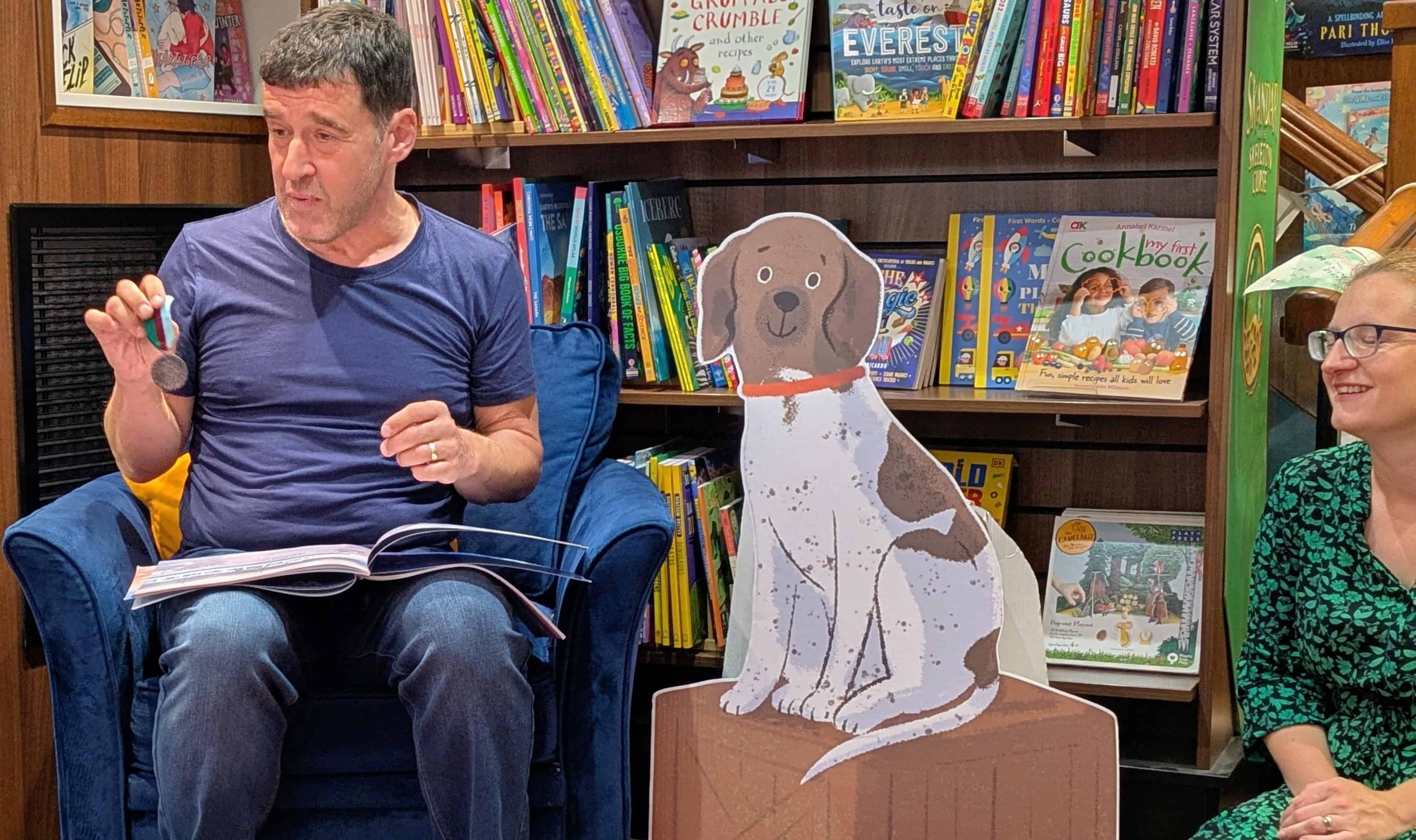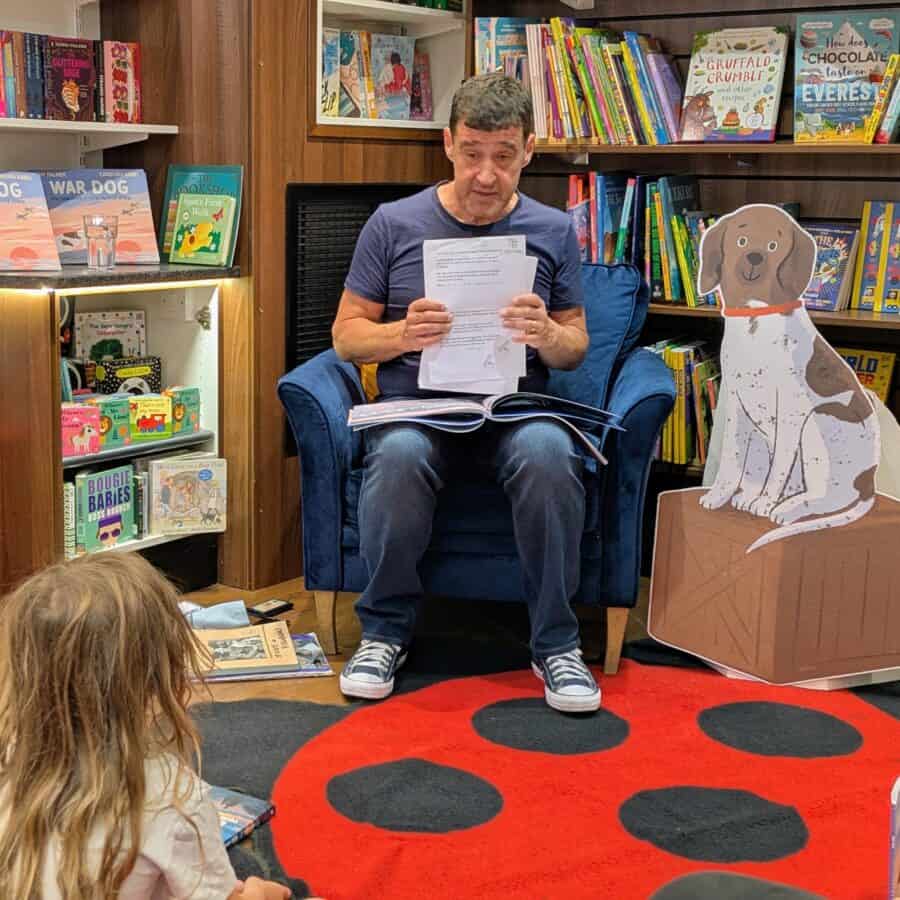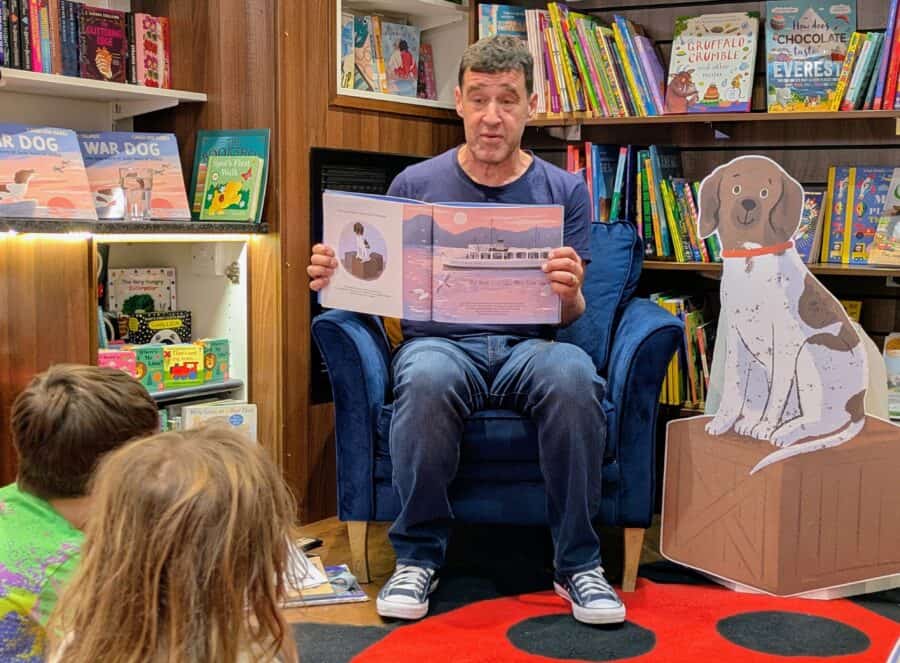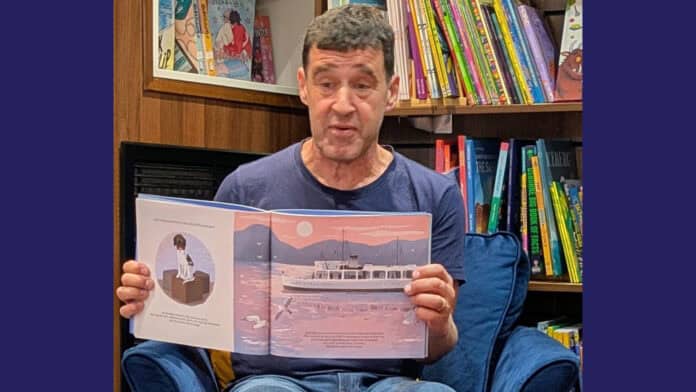By Noelle Williamson
As a boy, Tom Palmer didn’t like reading unless it was about football, but he went on to write 60 children’s novels, including three series about football, and some prize-winning historical fiction.
He was at Truman Books in Farsley on Tuesday to read and talk about War Dog, his new book for four to eight-year-olds, billed as ’one for all the family, especially animal lovers and those intrigued by true tales’. War Dog is Tom’s first non-fiction picture book and this was only his second storytelling session with it, so he was a bit nervous.
The War Dog was Judy, a ‘furry, four-legged hero of WWII’. When Tom set up a life-size cut-out of Judy, a child commented that she had nice eyes. It’s a measure of illustrator Carolina Rabei’s talent that this cardboard cut-out had a genuinely reassuring presence.
While Wendy (the regular storyteller) brought extra chairs, Tom asked Annie and Jay if they had a dog. They do, and not just one! How had they got them? The children quickly warmed to this fellow dog lover, and the nerves faded. When we were sitting comfortably, Wendy began. Why had Tom chosen to write this story now?
“Well, I’ve done books for older children, like D-Day Dog. Then another publisher said, ‘We’re looking to do some picture books, particularly about difficult subjects like war. Would you be interested?’ I was, absolutely!
“So, I did a two-book deal with them, and the second book is going to be called War Cat. It’s about a cat called Pyro, who used to fly with the men in the aeroplanes when it was really cold. Pyro used to sit inside one man’s jacket and keep his hands warm while he was flying!”
Though once a reluctant reader, Tom is a born storyteller – and he takes his craft seriously. At one point, he said: “It’s quite hard, you know, writing about warfare for children? I’ve read books to do with war with my daughter, like picture books, and I think it helped, you know, that she was hearing it from me.”
It’s clearly important to him to create tools for parents and teachers to help children understand this frightening aspect of human life.
Before we sat down, he had said to Zach, Annie and Jay, “It’s nice to have someone to talk with when you’re looking at a picture book, isn’t it?” They had all agreed.
I think every adult in the room quickly recognised that Tom Palmer, father and writer, knows his readers and his listeners, i.e. ‘children with a reading age of four to eight and the teachers and parents who will be reading this book with them.
For example, he came prepared with pictures of his dog, Finn, relating Judy’s significance for the crew to Finn’s place in his family, and perhaps encouraging reflection on the place of the pets in our own families.
At points in the story where Judy had to warn or protect the crew, or when she was anxious or in danger, Tom paused and put the children in the driving seat – getting them to consider her predicament and speculate about what abilities or options she had to work with.
He asked his listeners what they thought words meant, admired their reasoning if they were wrong, and encouraged more thought. He invited questions and thought out loud before offering his conclusion and checking whether they concurred.
It might sound longwinded, and you might think that the only thing keeping the kids on the floor awake was a numb bum or a nudge from Mum, but it actually felt like a story with a conversation running through it. No-one got shushed, or mocked for a thoughtful response that didn’t quite fit. And even though Tom was the most easy-going ‘tutor’ imaginable, it was a masterclass in reading about a difficult subject with children.
Tom Palmer’s clear, spare prose conveys danger, action, and the importance of Judy’s courage and sense of duty, but avoids drama or direct emotion. He has structured this war story for young readers in an undulating pattern of jeopardy and relief, jeopardy and relief.
Thus, we see: an attack on the ship, and Judy raising the alarm; Judy trapped in the hold, then rescued; Judy saving the stranded crew again by locating drinking water; the crew being detained, but smuggling Judy into the POW camp; Judy getting ‘wobbly’, then having puppies; the guards being ‘mean’ to the crew and Judy scratching them; the guards being ‘mean’ to Judy, but the commandant –
Tom: Does anyone know what a commandant is?
Jay/Zach/Annie?: Yeah, the big boss.
Tom: Yeah, the person in charge, like the prison governor.
… the commandant smiles to see her. I shall make Judy an official prisoner of war,” he says to Frank. “Now, she will be protected.”
In this telling of Judy’s story, Tom Palmer has left gaps which, as a parent observed, readers will fill according to their knowledge and maturity. Reading War Dog with a five-year-old, my mind’s eye sees aspects of life in a 1940s POW camp that text and illustrations only hint at.
The little one beside me takes it at face value: a true story of a dog who faces up to no end of trouble and gets a medal for her courage and resourcefulness. Still, for a modern fable, isn’t Judy’s example an encouraging one for any dog, boy or girl, growing up? Especially when one of the sailors takes her home after the war, because she’s his friend.
Listening to Tom’s voice, we heard apprehension in his low, slow delivery, and increasing tension as his pitch rose and fell, rose and fell; his words kept pace with Judy’s paws as she ran to alert the men below decks; but he respected his material and his audience: creating atmosphere, not drama.
“So, about Judy: Judy was a real dog in the Second World War. She was – Do you know what a prisoner of war was?” Zach shook his head. Annie said no. “A prisoner of war was – if a soldier or an airman or a sailor got caught by the enemy in the war, they were kept as a prisoner for the whole of the war, and then released at the end. Judy was the only animal ever to be made an official prisoner of war.”
Tom had brought a replica bronze medal on a striped ribbon, the PDSA Dickin Medal, which was awarded to 32 pigeons, one ship’s cat, 3 horses, and 18 dogs in World War II for “conspicuous gallantry or devotion to duty”. Judy was one of them.

Tom told the children about his research and showed them an A4 notebook full of “notes on everything I need for the story. “And then what I do is – without the artist – I do a first draft, and this -” (swapping the notebook for typed sheets, heavily annotated in pen) “This is like the fifth draft. Do you know what a draft is? Have you got a teacher who makes you rewrite things?” (Nods and wry faces from the floor) “When you think you’ve finished, yeah?” He put down his fifth draft.

“Now I’ll read a bit and then I’ll stop about a third of the way through, and if you’ve got any questions or anything like that…?”
Holding up the first illustrated spread, he asked the dog lovers “What kind of danger do you think dogs can listen for?” … “Yeah, the bombers, like five minutes before the people heard them, and the alarms went off. So… what else are they good at, as well as hearing?” “Smelling.”… “Yeah, like the smoke: they smell it. And that’s why they’re useful to us, certainly.”
He started reading.
And right now, Judy’s job is even more important than ever. The world is at war, and HMS Grasshopper is part of that war. It’s fierce and frightening, and Judy tries to remind her crew of their lives. Of home. She tries to give them hope…
“I’ll show you.”
These were the photos of Finn “and he’s lovely. And when things are not going quite right at home, he’s really loving, and he gives us hope. And then, like we were talking about dogs earlier, they’re lovely, aren’t they?
“So, that’s the beginning. And remember, this is all completely true. Everything that happened to them.”
Once the enemy have reached Singapore, HMS Grasshopper must escape. She steams out into the open sea. At first, the skies are quiet. Judy watches for enemy aircraft, and hearing it before any of the sailors, barks a warning. The men get in position. There is fear and fury as the enemy attacks.…
Judy smells fire. The men are in danger! She has to warn them. That is why they want her here. She runs through the dark corridors, barking, warning men to abandon the ship. The sailors scramble for the lifeboats….
Tom: So, she’s already saved them twice. Does anyone know the two things she’s done for them so far?
Annie: She’s barked and told them to evacuate.
“That’s right, brilliant. So that’s two different things she’s done, isn’t it? Who’s got a dog who barks, to help them?”
Jay: My grandma!
“So, the next pages – and look at these pictures. Just beautiful, aren’t they? The colours are lovely.” … “Carolina said she did them on an iPad. But they look a bit like watercolours.

An hour later, the survivors wash up on the beach of an island. “Where’s Judy?” One man asks. They look across the water at HMS Grasshopper burning, but still afloat. As the men search the island for water, they’re worried.…. Judy must be somewhere and she saved them, so they should save her.…
… It is dark inside the belly of HMS Grasshopper, where Judy is trapped, alone … but then she hears a new sound. Clang! Clang! Clang!
“What do you think that new sound is that she can hear?”
“Gunshots?”
“No, but there would have been gunshots around, so that was a really good answer. Yeah, any others? What do you think the clang clang clang might have been?”
“Men climbing down ladders.”
“Yeah, well done, very good. Someone coming down the metal ladder, clang clang clang. It’s kind of a dangerous situation, but hopefully someone’s on the way to rescue her.”
Annie: Why doesn’t she just like come off the ship and just jump into the water if she could swim?
Tom: That’s a really good question. As far as I remember from my research, she was trapped, down in the hold of the ship, and the only way out was – I’ll show you the picture…. There’s the ladder. A cat can climb, and I bet some sorts of dogs come to that point. Judy couldn’t, so she was trapped.
He read on, to the point when Judy became an official Prisoner of War, then gave us a synopsis of the rest. Although it isn’t in the book, he explained that Frank adopted Judy after the war, and took care of her for the rest of her life. “and when she died of old age, she was buried in a little grave, which is lovely, isn’t it?”
- Truman Books in Farsley offers stories and songs for under-5s every Tuesday and Thursday morning, 10.30am-11am.
Sponsored content


